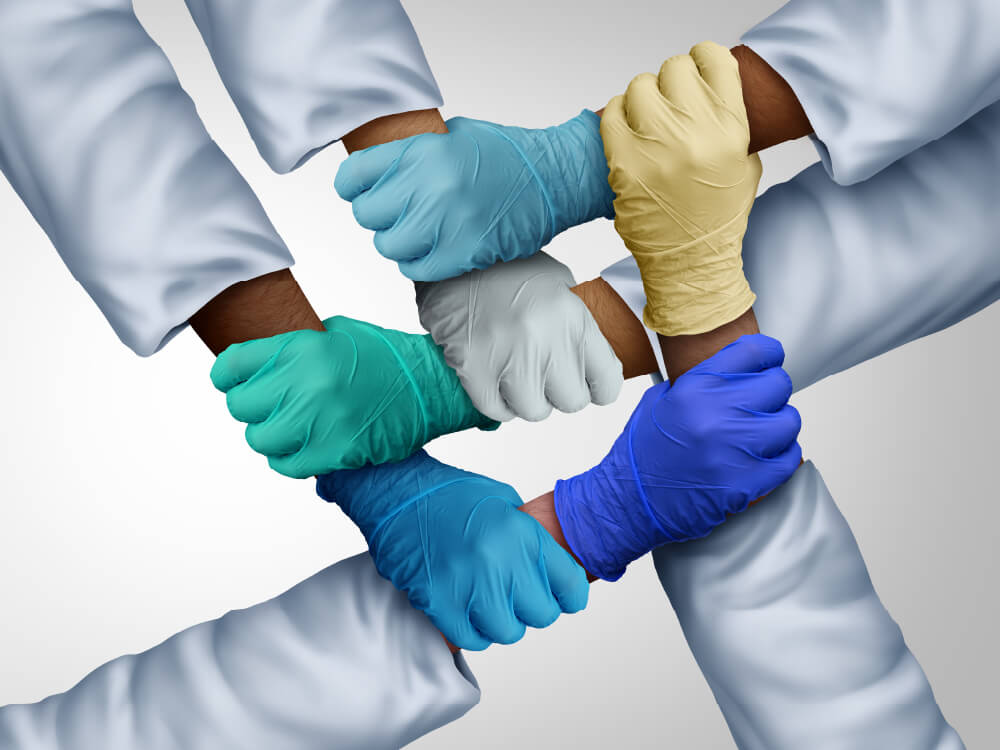Pharmacy schools are finding innovative approaches to interprofessional education, collaborating with other health professions to achieve improved patient outcomes.
By Jane E. Rooney
“Imagine a typical patient suffering from chronic pain. That person is dealing with multiple health professionals—sometimes up to 10 or 12 over time. Do they talk to each other? The answer typically is no. What patients are now dealing with is a highly truncated system in which information is not always shared and they get multiple pieces of advice,” said Dr. Frank Ascione, director, University of Michigan Center for Interprofessional Education (IPE), and former dean of the college of pharmacy.
Enter interprofessional education, which helps provide patients with a more coordinated approach to care and more efficient use of resources, he said, noting “the hope is that IPE leads to more satisfaction, more efficiency and healthier outcomes.” The World Health Organization defines IPE as occurring “when students from two or more professions learn about, from, and with each other to enable effective collaboration and improve health outcomes.” (“Learners” is now being used rather than students, to include clinicians and practicing health professionals.) Every pharmacy school must include IPE as part of ACPE accreditation standards. The Interprofessional Education Collaborative (IPEC), which represents 21 national health profession education associations—pharmacy among the original six professions included—developed the core competencies that pharmacy schools use to fulfill accreditation requirements.
“We know that teams impact outcomes if they are deployed properly and supported in the environment in which they work,” said Dr. Barbara Brandt, director, National Center for Interprofessional Practice and Education and professor in the College of Pharmacy at the University of Minnesota. “There’s a real need for educating health professionals as well as non-health professionals who they work with in the same setting to improve health outcomes. AACP being part of the IPEC group is absolutely critical in driving that conversation.”
Pharmacy has proven to be a trailblazer in IPE and has strong leadership compared to other health professions, Brandt continued, because it was one of the first to have robust accreditation standards back in the early 2000s. “There are a lot of pharmacy faculty members who have deep experience because they have been held accountable for a number of years so they are being tapped as leaders,” she said. “The visible leadership at some of these institutions is incredible. They are engaging physicians and other health professions across the board.”
Examples of innovations in IPE—some driven by the need to change course during the pandemic—are plentiful at pharmacy schools across the country. As the need for collaboration among health professionals increases, schools are adapting and exploring new ways to expose student pharmacists to IPE opportunities.
Understanding Other Disciplines
The University of Michigan Center for IPE came to fruition in 2015 thanks to support and funding from the administration and faculty buy-in. As Ascione was stepping down as dean of the college of pharmacy, faculty returning from an IPEC conference expressed enthusiasm for developing a team-based clinical decision-making course. Ascione asked for and received support from the deans and provost to lead an IPE center. “I recognized that we had this grassroots movement so I saw the support for it was there. At the same time, the university was engaged in a third century funding grant, so there was money available for a [$3 million] transitional grant,” he said. “Pharmacy is ideal in terms of engaging in [IPE]. We’re inherently a team-based profession. We practice across the whole healthcare span, from the institutional to the community setting. In terms of addressing healthcare problems, we’re in an ideal spot to do something. It would be difficult to engage in the interprofessional movement without pharmacy involved.”
The Center takes a menu-based approach with its IPE offerings. “One big premise is, how can you learn about what someone does if you don’t know anything about them? We provide an opportunity to learn about the backgrounds of other professions. That’s the basis for anything else. You need to know the expertise of other people you’re working with,” he emphasized, adding that engaging in team-based behavior is a necessity at Michigan, which has 14 disciplines involved in IPE. Students must interact with at least one other profession, and being a large and diverse school offers advantages in terms of broader IPE experiences.

